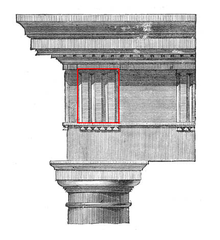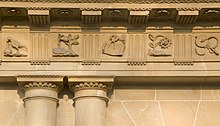
Back ثلاثية الأخاديد Arabic Triqlif AZ Трыгліф BE Трыгліф BE-X-OLD Триглиф Bulgarian Triglif BS Tríglif Catalan Triglyf Czech Triglyf Danish Triglyphe German


Triglyph is an architectural term for the vertically channeled tablets of the Doric frieze in classical architecture, so called because of the angular channels in them. The rectangular recessed spaces between the triglyphs on a Doric frieze are called metopes.[1] The raised spaces between the channels themselves (within a triglyph) are called femur in Latin or meros in Greek.[2] In the strict tradition of classical architecture, a set of guttae, the six triangular "pegs" below, always go with a triglyph above (and vice versa), and the pair of features are only found in entablatures of buildings using the Doric order. The absence of the pair effectively converts a building from being in the Doric order to being in the Tuscan order.
The triglyph is largely thought to be a tectonic and skeuomorphic representation in stone of the wooden beam ends of the typical primitive hut, as described by Vitruvius and Renaissance writers. The wooden beams were notched in three separate places in order to cast their rough-cut ends mostly in shadow. Greek architecture (and later Roman architecture) preserved this feature, as well as many other features common in original wooden buildings, as a tribute to the origins of architecture and its role in the history and development of man. The channels could also have a function in channeling rainwater.[citation needed][original research?]
- ^ One or more of the preceding sentences incorporates text from a publication now in the public domain: Chisholm, Hugh, ed. (1911). "Triglyph". Encyclopædia Britannica. Vol. 27 (11th ed.). Cambridge University Press. p. 271.
- ^ Joseph Rykwert (1998). The Dancing Column: On Order in Architecture. MIT Press. p. 187. ISBN 0-262-68101-3.